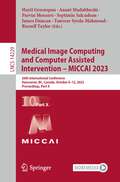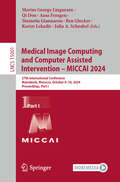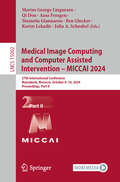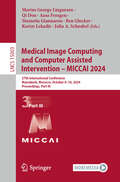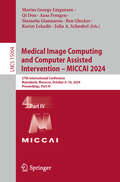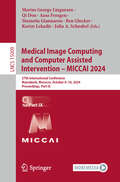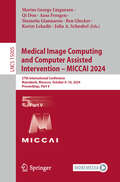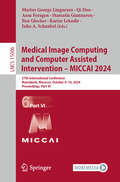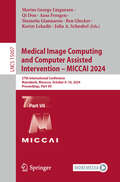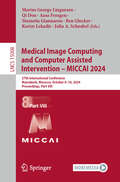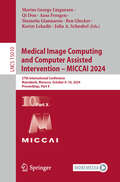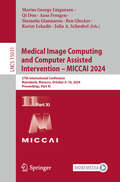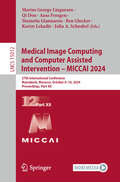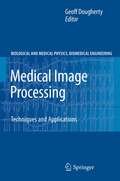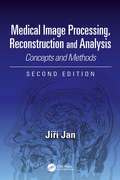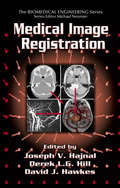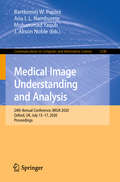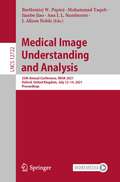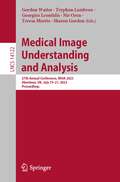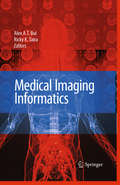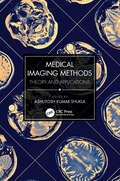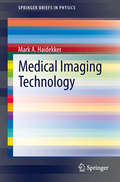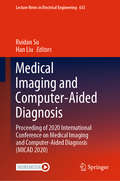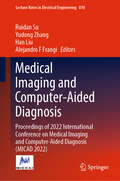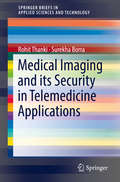- Table View
- List View
Medical Image Computing and Computer Assisted Intervention – MICCAI 2023: 26th International Conference, Vancouver, BC, Canada, October 8–12, 2023, Proceedings, Part X (Lecture Notes in Computer Science #14229)
by James Duncan Tanveer Syeda-Mahmood Hayit Greenspan Anant Madabhushi Russell Taylor Parvin Mousavi Septimiu SalcudeanThe ten-volume set LNCS 14220, 14221, 14222, 14223, 14224, 14225, 14226, 14227, 14228, and 14229 constitutes the refereed proceedings of the 26th International Conference on Medical Image Computing and Computer-Assisted Intervention, MICCAI 2023, which was held in Vancouver, Canada, in October 2023. The 730 revised full papers presented were carefully reviewed and selected from a total of 2250 submissions. The papers are organized in the following topical sections: Part I: Machine learning with limited supervision and machine learning – transfer learning; Part II: Machine learning – learning strategies; machine learning – explainability, bias, and uncertainty; Part III: Machine learning – explainability, bias and uncertainty; image segmentation; Part IV: Image segmentation; Part V: Computer-aided diagnosis; Part VI: Computer-aided diagnosis; computational pathology; Part VII: Clinical applications – abdomen; clinical applications – breast; clinical applications – cardiac; clinical applications – dermatology; clinical applications – fetal imaging; clinical applications – lung; clinical applications – musculoskeletal; clinical applications – oncology; clinical applications – ophthalmology; clinical applications – vascular; Part VIII: Clinical applications – neuroimaging; microscopy; Part IX: Image-guided intervention, surgical planning, and data science; Part X: Image reconstruction and image registration.
Medical Image Computing and Computer Assisted Intervention – MICCAI 2024: 27th International Conference, Marrakesh, Morocco, October 6–10, 2024, Proceedings, Part I (Lecture Notes in Computer Science #15001)
by Marius George Linguraru Aasa Feragen Ben Glocker Julia A. Schnabel Karim Lekadir Qi Dou Stamatia GiannarouThe 12-volume set LNCS 15001 - 15012 constitutes the proceedings of the 27th International Conferenc on Medical Image Computing and Computer Assisted Intervention, MICCAI 2024, which took place in Marrakesh, Morocco, during October 6–10, 2024. MICCAI accepted 857 full papers from 2781 submissions. They focus on neuroimaging; image registration; computational pathology; computer aided diagnosis, treatment response, and outcome prediction; image guided intervention; visualization; surgical planning, and surgical data science; image reconstruction; image segmentation; machine learning; etc.
Medical Image Computing and Computer Assisted Intervention – MICCAI 2024: 27th International Conference, Marrakesh, Morocco, October 6–10, 2024, Proceedings, Part II (Lecture Notes in Computer Science #15002)
by Marius George Linguraru Aasa Feragen Ben Glocker Julia A. Schnabel Karim Lekadir Qi Dou Stamatia GiannarouThe 12-volume set LNCS 15001 - 15012 constitutes the proceedings of the 27th International Conferenc on Medical Image Computing and Computer Assisted Intervention, MICCAI 2024, which took place in Marrakesh, Morocco, during October 6–10, 2024. MICCAI accepted 857 full papers from 2781 submissions. They focus on neuroimaging; image registration; computational pathology; computer aided diagnosis, treatment response, and outcome prediction; image guided intervention; visualization; surgical planning, and surgical data science; image reconstruction; image segmentation; machine learning; etc.
Medical Image Computing and Computer Assisted Intervention – MICCAI 2024: 27th International Conference, Marrakesh, Morocco, October 6–10, 2024, Proceedings, Part III (Lecture Notes in Computer Science #15003)
by Marius George Linguraru Aasa Feragen Ben Glocker Julia A. Schnabel Karim Lekadir Qi Dou Stamatia GiannarouThe 12-volume set LNCS 15001 - 15012 constitutes the proceedings of the 27th International Conferenc on Medical Image Computing and Computer Assisted Intervention, MICCAI 2024, which took place in Marrakesh, Morocco, during October 6–10, 2024. MICCAI accepted 857 full papers from 2781 submissions. They focus on neuroimaging; image registration; computational pathology; computer aided diagnosis, treatment response, and outcome prediction; image guided intervention; visualization; surgical planning, and surgical data science; image reconstruction; image segmentation; machine learning; etc.
Medical Image Computing and Computer Assisted Intervention – MICCAI 2024: 27th International Conference, Marrakesh, Morocco, October 6–10, 2024, Proceedings, Part IV (Lecture Notes in Computer Science #15004)
by Marius George Linguraru Aasa Feragen Ben Glocker Julia A. Schnabel Karim Lekadir Qi Dou Stamatia GiannarouThe 12-volume set LNCS 15001 - 15012 constitutes the proceedings of the 27th International Conferenc on Medical Image Computing and Computer Assisted Intervention, MICCAI 2024, which took place in Marrakesh, Morocco, during October 6–10, 2024. MICCAI accepted 857 full papers from 2781 submissions. They focus on neuroimaging; image registration; computational pathology; computer aided diagnosis, treatment response, and outcome prediction; image guided intervention; visualization; surgical planning, and surgical data science; image reconstruction; image segmentation; machine learning; etc.
Medical Image Computing and Computer Assisted Intervention – MICCAI 2024: 27th International Conference, Marrakesh, Morocco, October 6–10, 2024, Proceedings, Part IX (Lecture Notes in Computer Science #15009)
by Marius George Linguraru Aasa Feragen Ben Glocker Julia A. Schnabel Karim Lekadir Qi Dou Stamatia GiannarouThe 12-volume set LNCS 15001 - 15012 constitutes the proceedings of the 27th International Conferenc on Medical Image Computing and Computer Assisted Intervention, MICCAI 2024, which took place in Marrakesh, Morocco, during October 6–10, 2024. MICCAI accepted 857 full papers from 2781 submissions. They focus on neuroimaging; image registration; computational pathology; computer aided diagnosis, treatment response, and outcome prediction; image guided intervention; visualization; surgical planning, and surgical data science; image reconstruction; image segmentation; machine learning; etc.
Medical Image Computing and Computer Assisted Intervention – MICCAI 2024: 27th International Conference, Marrakesh, Morocco, October 6–10, 2024, Proceedings, Part V (Lecture Notes in Computer Science #15005)
by Marius George Linguraru Aasa Feragen Ben Glocker Julia A. Schnabel Karim Lekadir Qi Dou Stamatia GiannarouThe 12-volume set LNCS 15001 - 15012 constitutes the proceedings of the 27th International Conferenc on Medical Image Computing and Computer Assisted Intervention, MICCAI 2024, which took place in Marrakesh, Morocco, during October 6–10, 2024. MICCAI accepted 857 full papers from 2781 submissions. They focus on neuroimaging; image registration; computational pathology; computer aided diagnosis, treatment response, and outcome prediction; image guided intervention; visualization; surgical planning, and surgical data science; image reconstruction; image segmentation; machine learning; etc.
Medical Image Computing and Computer Assisted Intervention – MICCAI 2024: 27th International Conference, Marrakesh, Morocco, October 6–10, 2024, Proceedings, Part VI (Lecture Notes in Computer Science #15006)
by Marius George Linguraru Aasa Feragen Ben Glocker Julia A. Schnabel Karim Lekadir Qi Dou Stamatia GiannarouThe 12-volume set LNCS 15001 - 15012 constitutes the proceedings of the 27th International Conferenc on Medical Image Computing and Computer Assisted Intervention, MICCAI 2024, which took place in Marrakesh, Morocco, during October 6–10, 2024. MICCAI accepted 857 full papers from 2781 submissions. They focus on neuroimaging; image registration; computational pathology; computer aided diagnosis, treatment response, and outcome prediction; image guided intervention; visualization; surgical planning, and surgical data science; image reconstruction; image segmentation; machine learning; etc.
Medical Image Computing and Computer Assisted Intervention – MICCAI 2024: 27th International Conference, Marrakesh, Morocco, October 6–10, 2024, Proceedings, Part VII (Lecture Notes in Computer Science #15007)
by Marius George Linguraru Aasa Feragen Ben Glocker Julia A. Schnabel Karim Lekadir Qi Dou Stamatia GiannarouThe 12-volume set LNCS 15001 - 15012 constitutes the proceedings of the 27th International Conferenc on Medical Image Computing and Computer Assisted Intervention, MICCAI 2024, which took place in Marrakesh, Morocco, during October 6–10, 2024. MICCAI accepted 857 full papers from 2781 submissions. They focus on neuroimaging; image registration; computational pathology; computer aided diagnosis, treatment response, and outcome prediction; image guided intervention; visualization; surgical planning, and surgical data science; image reconstruction; image segmentation; machine learning; etc.
Medical Image Computing and Computer Assisted Intervention – MICCAI 2024: 27th International Conference, Marrakesh, Morocco, October 6–10, 2024, Proceedings, Part VIII (Lecture Notes in Computer Science #15008)
by Marius George Linguraru Aasa Feragen Ben Glocker Julia A. Schnabel Karim Lekadir Qi Dou Stamatia GiannarouThe 12-volume set LNCS 15001 - 15012 constitutes the proceedings of the 27th International Conferenc on Medical Image Computing and Computer Assisted Intervention, MICCAI 2024, which took place in Marrakesh, Morocco, during October 6–10, 2024. MICCAI accepted 857 full papers from 2781 submissions. They focus on neuroimaging; image registration; computational pathology; computer aided diagnosis, treatment response, and outcome prediction; image guided intervention; visualization; surgical planning, and surgical data science; image reconstruction; image segmentation; machine learning; etc.
Medical Image Computing and Computer Assisted Intervention – MICCAI 2024: 27th International Conference, Marrakesh, Morocco, October 6–10, 2024, Proceedings, Part X (Lecture Notes in Computer Science #15010)
by Marius George Linguraru Aasa Feragen Ben Glocker Julia A. Schnabel Karim Lekadir Qi Dou Stamatia GiannarouThe 12-volume set LNCS 15001 - 15012 constitutes the proceedings of the 27th International Conferenc on Medical Image Computing and Computer Assisted Intervention, MICCAI 2024, which took place in Marrakesh, Morocco, during October 6–10, 2024. MICCAI accepted 857 full papers from 2781 submissions. They focus on neuroimaging; image registration; computational pathology; computer aided diagnosis, treatment response, and outcome prediction; image guided intervention; visualization; surgical planning, and surgical data science; image reconstruction; image segmentation; machine learning; etc.
Medical Image Computing and Computer Assisted Intervention – MICCAI 2024: 27th International Conference, Marrakesh, Morocco, October 6–10, 2024, Proceedings, Part XI (Lecture Notes in Computer Science #15011)
by Marius George Linguraru Aasa Feragen Ben Glocker Julia A. Schnabel Karim Lekadir Qi Dou Stamatia GiannarouThe 12-volume set LNCS 15001 - 15012 constitutes the proceedings of the 27th International Conferenc on Medical Image Computing and Computer Assisted Intervention, MICCAI 2024, which took place in Marrakesh, Morocco, during October 6–10, 2024. MICCAI accepted 857 full papers from 2781 submissions. They focus on neuroimaging; image registration; computational pathology; computer aided diagnosis, treatment response, and outcome prediction; image guided intervention; visualization; surgical planning, and surgical data science; image reconstruction; image segmentation; machine learning; etc.
Medical Image Computing and Computer Assisted Intervention – MICCAI 2024: 27th International Conference, Marrakesh, Morocco, October 6–10, 2024, Proceedings, Part XII (Lecture Notes in Computer Science #15012)
by Marius George Linguraru Aasa Feragen Ben Glocker Julia A. Schnabel Karim Lekadir Qi Dou Stamatia GiannarouThe 12-volume set LNCS 15001 - 15012 constitutes the proceedings of the 27th International Conferenc on Medical Image Computing and Computer Assisted Intervention, MICCAI 2024, which took place in Marrakesh, Morocco, during October 6–10, 2024. MICCAI accepted 857 full papers from 2781 submissions. They focus on neuroimaging; image registration; computational pathology; computer aided diagnosis, treatment response, and outcome prediction; image guided intervention; visualization; surgical planning, and surgical data science; image reconstruction; image segmentation; machine learning; etc.
Medical Image Processing
by Geoff DoughertyThe book is designed for end users in the field of digital imaging, who wish to update their skills and understanding with the latest techniques in image analysis. The book emphasizes the conceptual framework of image analysis and the effective use of image processing tools. It uses applications in a variety of fields to demonstrate and consolidate both specific and general concepts, and to build intuition, insight and understanding. Although the chapters are essentially self-contained they reference other chapters to form an integrated whole. Each chapter employs a pedagogical approach to ensure conceptual learning before introducing specific techniques and "tricks of the trade". The book concentrates on a number of current research applications, and will present a detailed approach to each while emphasizing the applicability of techniques to other problems. The field of topics is wide, ranging from compressive (non-uniform) sampling in MRI, through automated retinal vessel analysis to 3-D ultrasound imaging and more. The book is amply illustrated with figures and applicable medical images. The reader will learn the techniques which experts in the field are currently employing and testing to solve particular research problems, and how they may be applied to other problems.
Medical Image Processing, Reconstruction and Analysis: Concepts and Methods, Second Edition (Signal Processing and Communications #2)
by Jiri JanDifferently oriented specialists and students involved in image processing and analysis need to have a firm grasp of concepts and methods used in this now widely utilized area. This book aims at being a single-source reference providing such foundations in the form of theoretical yet clear and easy to follow explanations of underlying generic concepts. Medical Image Processing, Reconstruction and Analysis – Concepts and Methods explains the general principles and methods of image processing and analysis, focusing namely on applications used in medical imaging. The content of this book is divided into three parts: Part I – Images as Multidimensional Signals provides the introduction to basic image processing theory, explaining it for both analogue and digital image representations. Part II – Imaging Systems as Data Sources offers a non-traditional view on imaging modalities, explaining their principles influencing properties of the obtained images that are to be subsequently processed by methods described in this book. Newly, principles of novel modalities, as spectral CT, functional MRI, ultrafast planar-wave ultrasonography and optical coherence tomography are included. Part III – Image Processing and Analysis focuses on tomographic image reconstruction, image fusion and methods of image enhancement and restoration; further it explains concepts of low-level image analysis as texture analysis, image segmentation and morphological transforms. A new chapter deals with selected areas of higher-level analysis, as principal and independent component analysis and particularly the novel analytic approach based on deep learning. Briefly, also the medical image-processing environment is treated, including processes for image archiving and communication. Features Presents a theoretically exact yet understandable explanation of image processing and analysis concepts and methods Offers practical interpretations of all theoretical conclusions, as derived in the consistent explanation Provides a concise treatment of a wide variety of medical imaging modalities including novel ones, with respect to properties of provided image data
Medical Image Registration
by Joseph V. Hajnal David J. Hawkes Derek L.G. HillImage registration is the process of systematically placing separate images in a common frame of reference so that the information they contain can be optimally integrated or compared. This is becoming the central tool for image analysis, understanding, and visualization in both medical and scientific applications. Medical Image Registration provid
Medical Image Understanding and Analysis: 24th Annual Conference, MIUA 2020, Oxford, UK, July 15-17, 2020, Proceedings (Communications in Computer and Information Science #1248)
by Bartłomiej W. Papież Ana I. L. Namburete Mohammad Yaqub J. Alison NobleThis book constitutes the refereed proceedings of the 24th Conference on Medical Image Understanding and Analysis, MIUA 2020, held in July 2020. Due to COVID-19 pandemic the conference was held virtually. The 29 full papers and 5 short papers presented were carefully reviewed and selected from 70 submissions. They were organized according to following topical sections: image segmentation; image registration, reconstruction and enhancement; radiomics, predictive models, and quantitative imaging biomarkers; ocular imaging analysis; biomedical simulation and modelling.
Medical Image Understanding and Analysis: 25th Annual Conference, MIUA 2021, Oxford, United Kingdom, July 12–14, 2021, Proceedings (Lecture Notes in Computer Science #12722)
by Bartłomiej W. Papież Ana I. L. Namburete Mohammad Yaqub J. Alison Noble Jianbo JiaoThis book constitutes the refereed proceedings of the 25th Conference on Medical Image Understanding and Analysis, MIUA 2021, held in July 2021. Due to COVID-19 pandemic the conference was held virtually. The 32 full papers and 8 short papers presented were carefully reviewed and selected from 77 submissions. They were organized according to following topical sections: biomarker detection; image registration, and reconstruction; image segmentation; generative models, biomedical simulation and modelling; classification; image enhancement, quality assessment, and data privacy; radiomics, predictive models, and quantitative imaging.
Medical Image Understanding and Analysis: 27th Annual Conference, MIUA 2023, Aberdeen, UK, July 19–21, 2023, Proceedings (Lecture Notes in Computer Science #14122)
by Sharon Gordon Nir Oren Gordon Waiter Tryphon Lambrou Georgios Leontidis Teresa MorrisThis book constitutes the proceedings of the 27th Annual Conference on Medical Image Understanding and Analysis, MIUA 2023, which took place in Aberdeen, UK, during July 19–21, 2023.The 24 full papers presented in this book were carefully reviewed and selected from 42 submissions. They were organized in topical sections as follows: Image interpretation; radiomics, predictive models and quantitative imaging; image classification; and biomarker detection.
Medical Imaging Informatics
by Ricky K. Taira Alex A.T. BuiMedical Imaging Informatics provides an overview of this growing discipline, which stems from an intersection of biomedical informatics, medical imaging, computer science and medicine. Supporting two complementary views, this volume explores the fundamental technologies and algorithms that comprise this field, as well as the application of medical imaging informatics to subsequently improve healthcare research. Clearly written in a four part structure, this introduction follows natural healthcare processes, illustrating the roles of data collection and standardization, context extraction and modeling, and medical decision making tools and applications. Medical Imaging Informatics identifies core concepts within the field, explores research challenges that drive development, and includes current state-of-the-art methods and strategies.
Medical Imaging Methods: Theory and Applications
by Ashutosh Kumar ShuklaThis volume presents pedagogical content to understand theoretical and practical aspects of diagnostic imaging techniques. It provides insights to current practices, and also discusses specific practical features like radiation exposure, radiation sensitivity, signal penetration, tissue interaction, and signal confinement with reference to individual imaging techniques. It also covers relatively less common imaging methods in addition to the established ones. It serves as a reference for researchers and students working in the field of medical, biomedical science, physics, and instrumentation. Key Features• Focusses on the clinical applications while ensuring a steady understanding of the underlying science• Follows a bottom-up approach to cover the theory, calculations, and modalities to aid students and researchers in biomedical imaging, radiology and instrumentation• Covers unique concepts of nanoparticle applications along with ethical issues in medical imaging
Medical Imaging Technology
by Mark A HaidekkerBiomedical imaging is a relatively young discipline that started with Conrad Wilhelm Roentgen's discovery of the x-ray in 1895. X-ray imaging was rapidly adopted in hospitals around the world. However, it was the advent of computerized data and image processing that made revolutionary new imaging modalities possible. Today, cross-sections and three-dimensional reconstructions of the organs inside the human body is possible with unprecedented speed, detail and quality. This book provides an introduction into the principles of image formation of key medical imaging modalities: X-ray projection imaging, x-ray computed tomography, magnetic resonance imaging, ultrasound imaging, and radionuclide imaging. Recent developments in optical imaging are also covered. For each imaging modality, the introduction into the physical principles and sources of contrast is provided, followed by the methods of image formation, engineering aspects of the imaging devices, and a discussion of strengths and limitations of the modality. With this book, the reader gains a broad foundation of understanding and knowledge how today's medical imaging devices operate. In addition, the chapters in this book can serve as an entry point for the in-depth study of individual modalities by providing the essential basics of each modality in a comprehensive and easy-to-understand manner. As such, this book is equally attractive as a textbook for undergraduate or graduate biomedical imaging classes and as a reference and self-study guide for more specialized in-depth studies.
Medical Imaging and Computer-Aided Diagnosis: Proceeding of 2020 International Conference on Medical Imaging and Computer-Aided Diagnosis (MICAD 2020) (Lecture Notes in Electrical Engineering #633)
by Han Liu Ruidan SuThis book covers virtually all aspects of image formation in medical imaging, including systems based on ionizing radiation (x-rays, gamma rays) and non-ionizing techniques (ultrasound, optical, thermal, magnetic resonance, and magnetic particle imaging) alike. In addition, it discusses the development and application of computer-aided detection and diagnosis (CAD) systems in medical imaging. Given its coverage, the book provides both a forum and valuable resource for researchers involved in image formation, experimental methods, image performance, segmentation, pattern recognition, feature extraction, classifier design, machine learning / deep learning, radiomics, CAD workstation design, human–computer interaction, databases, and performance evaluation.
Medical Imaging and Computer-Aided Diagnosis: Proceedings of 2022 International Conference on Medical Imaging and Computer-Aided Diagnosis (MICAD 2022) (Lecture Notes in Electrical Engineering #810)
by Han Liu Ruidan Su Yudong Zhang Alejandro F FrangiThis book covers virtually all aspects of image formation in medical imaging, including systems based on ionizing radiation (x-rays, gamma rays) and non-ionizing techniques (ultrasound, optical, thermal, magnetic resonance, and magnetic particle imaging) alike. In addition, it discusses the development and application of computer-aided detection and diagnosis (CAD) systems in medical imaging. Given its coverage, the book provides both a forum and valuable resource for researchers involved in image formation, experimental methods, image performance, segmentation, pattern recognition, feature extraction, classifier design, machine learning / deep learning, radiomics, CAD workstation design, human–computer interaction, databases, and performance evaluation.
Medical Imaging and its Security in Telemedicine Applications (SpringerBriefs in Applied Sciences and Technology)
by Rohit Thanki Surekha BorraThis book introduces medical imaging, its security requirements, and various security mechanisms using data hiding approaches. The book in particular provides medical data hiding techniques using various advanced image transforms and encryption methods. The book focuses on two types of data hiding techniques: steganography and watermarking for medical images. The authors show how these techniques are used for security and integrity verification of medical images and designed for various types of medical images such as grayscale image and color image. The implementation of techniques are done using discrete cosine transform (DCT), discrete wavelet transform (DWT), singular value decomposition (SVD), redundant DWT (RDWT), fast discrete curvelet transform (FDCuT), finite ridgelet transform (FRT) and non-subsampled contourlet transform (NSCT). The results of these techniques are also demonstrated after description of each technique. Finally, some future research directions are provided for security of medical images in telemedicine application.
